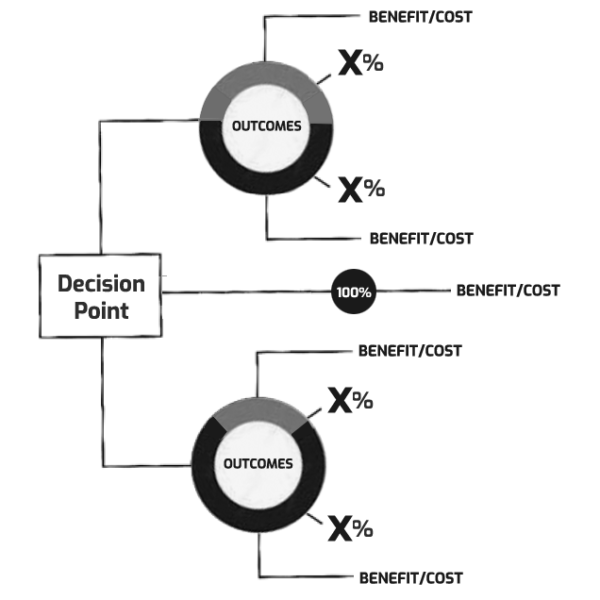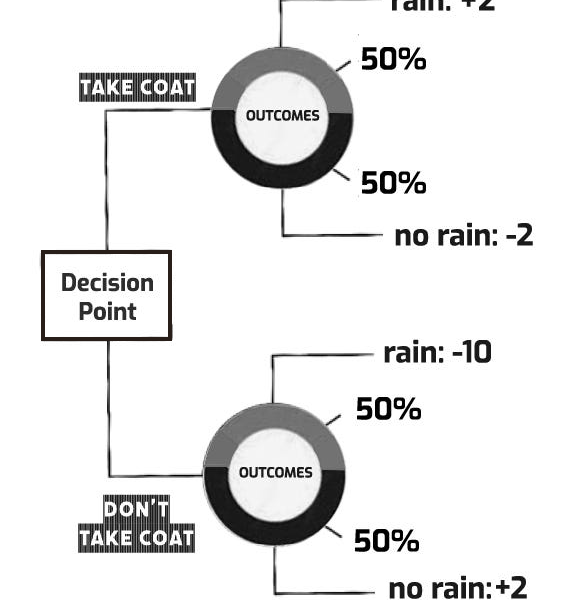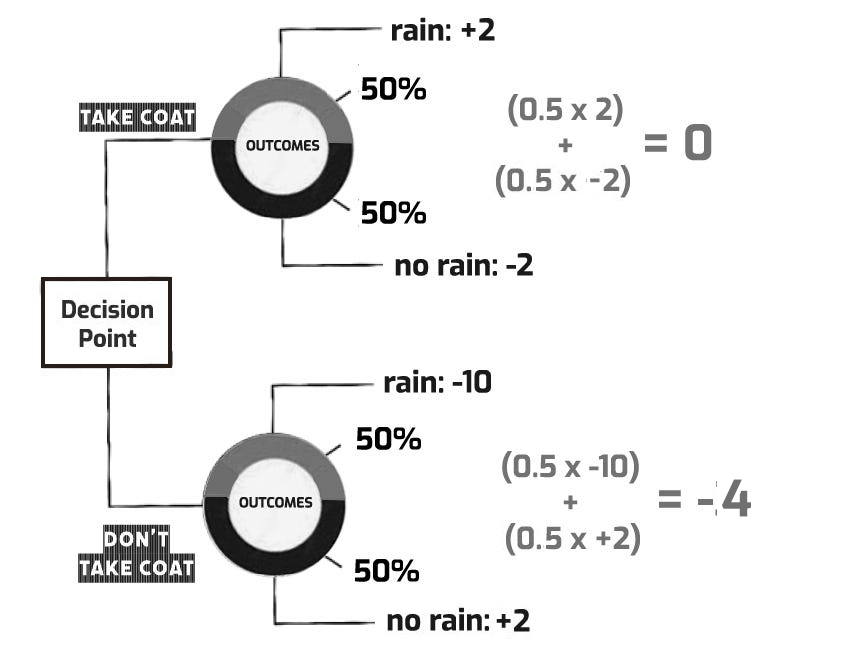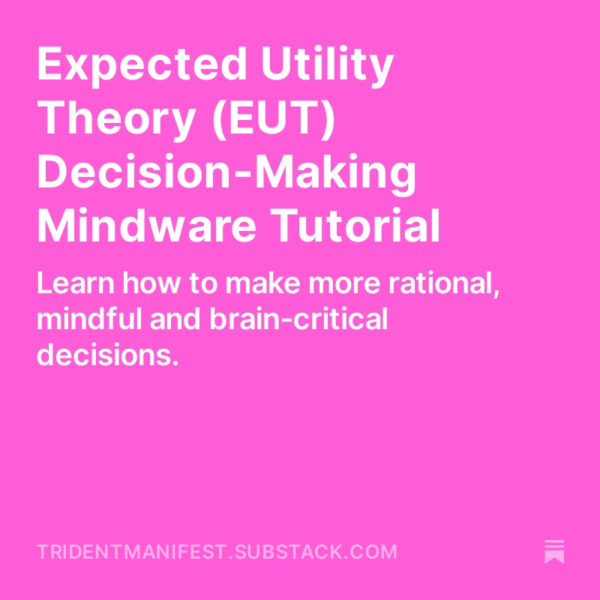We often make decisions when the outcomes of our actions are uncertain:
- Should I take a coat when I go out?
- Should I try a new recipe for dinner or stick with a favourite?
- Should I take a different route to avoid traffic?
- Should I move to a new city for a better opportunity?
- Should I invest in this new business venture?
- Should I have this surgery?
- Should I end a long-term relationship?
Expected Utility Theory (EUT) decision-making mindware gives you a rational method for making these kinds of decisions where outcomes for each option of your choice are uncertain.
Something’s utility is the degree of satisfaction or pleasure we get from it as a benefit, or the degree of dissatisfaction or pain we get from it as a cost.. The slogan of EUT is: choose the option with the highest expected utility. The general form of EUT mindware is shown in the diagram below, which shows a choice between 3 actions, where one action has just one outcome that is guaranteed (100% probability), and the other two actions have two possible outcomes each with different probabilities assigned to them. Each possible outcome has an associated utility which depends on our individual preferences and values.

This is an example of a more general form of an EUT decision tree diagram involving actions/options at decision-points, and possible outcomes with associated likelihoods and utilities (benefits/costs). The possible outcomes need to be mutually exclusive so all probabilities add to 1. There may be 2, 3 or 4 actions that could be taken. Each action could result in just one certain outcome, or 2, 3, 4…possible outcomes each with an estimated likelihood. You can play around with this diagram for your own purposes.
So for this decision: Should I take a coat when I go out? Here we have two actions – take the coat or leave it. For each action we have ‘it rains’ or ‘it doesn’t rain’ as possible outcomes, and the likelihood of it raining (based on the day) is estimated at 50/50. So what about utilities (benefits/costs). We put these on a single scale from -10 (awful) to +10 (amazing). If it rains and we have our coat, that’s given a +2 (nice to feel dry in the rain). If it rains and we don’t have a coat, that’s given a -10 (awful). If it doesn’t rain and we have our coat that’s given a -2 (inconvenient), and if it doesn’t rain and we don’t have a coat that’s given a +2 (nice to know we’re not encumbered).
This is an example of a more general form of an EUT decision tree diagram involving actions/options at decision-points, and possible outcomes with associated likelihoods and utilities (benefits/costs). The possible outcomes need to be mutually exclusive so all probabilities add to 1. There may be 2, 3 or 4 actions that could be taken. Each action could result in just one certain outcome, or 2, 3, 4…possible outcomes each with an estimated likelihood. You can play around with this diagram for your own purposes.
So for this decision: Should I take a coat when I go out? Here we have two actions – take the coat or leave it. For each action we have ‘it rains’ or ‘it doesn’t rain’ as possible outcomes, and the likelihood of it raining (based on the day) is estimated at 50/50. So what about utilities (benefits/costs). We put these on a single scale from -10 (awful) to +10 (amazing). If it rains and we have our coat, that’s given a +2 (nice to feel dry in the rain). If it rains and we don’t have a coat, that’s given a -10 (awful). If it doesn’t rain and we have our coat that’s given a -2 (inconvenient), and if it doesn’t rain and we don’t have a coat that’s given a +2 (nice to know we’re not encumbered).
EUT Decision Space
This is an EUT decision space and it’s shown in this decision tree diagram:

Mindware Practices 1: EUT Decision Spaces
To practise constructing EUT decision spaces, first familiarise yourself with the components of the diagram above, and work through some of your own examples on paper.
After doing it on paper, try working through some decisions in your mind’s eye – internally, using your working memory’s workspace.
- Looking back: Reflect on a past decision that had consequences. Mentally reconstruct the decision-making process, considering the alternatives you had at the time, building a complete decision space for the options available to you.
- Daily practice: Identify a choice you need to make today, and mentally map out the different actions you can take, and their possible outcomes with associated likelihoods and utilities (costs/benefits).
This practice of generating and evaluating options exercises your:
- Ability to sustain focus on a train of thought.
- Ability to generate possible futures in your mind’s eye.
- Working memory capacity – to hold all the information in mind without losing track
- Ability to judge likelihoods of outcomes.
- Ability to evaluate the value of the outcomes to you. This requires emotional intelligence (EQ) – the ability to emotionally stimulate your experience of benefits or costs even though they are not in the present.
EUT Decision Execution
To extend the decision space mindware above, we can now apply the ‘net expected utility’ rule for each action we can take in a decision. We multiply the utilities of each possible outcome for an action by their likelihoods to get expected utilities for each outcome. We then add these up for each action to get the net expected utility for each action. We select the action that scores highest. In the case of taking a coat or not, we choose to take the coat.

Mindware Practices 2: EUT Decision Execution
To practise making rational decisions using EUT mindware, first ensure you can create complete decision spaces in your working memory’s workspace. Practise this first!
Now you’ll need some basic mental arithmetic. You need to multiply the likelihoods for each possible outcome by their utilities and then add them for the overall net expected utility for each action. Work through some of your own examples on paper first, but as soon as you can, transition to working this out in your own mind – your mental workspace. You could try the following:
- Looking back: Reflect on a past decision that had consequences. Mentally reconstruct the decision space as in the previous practice, but now also compute the net expected utilities for each action you could have taken, and identify the best action you should have taken. Did you decide on this action at the time?
- Daily practice: Identify a choice that needs making today, and mentally construct the decision space and then the net expected utilities for each action to arrive at a rational decision. Act accordingly!
- Research and experiment with your likelihood estimates: Sometimes we don’t have a clear idea about likelihoods or risks of outcomes, and doing some online research can help with our estimates. Also, try running through the EUT decision-making process over a range of likelihood estimates. It can be helpful to consider a range of probabilities and see if you reach the same overall decision. In the raincoat example, you could try 25% chance of rain as well as the 50% chance we considered.
This practice of making decisions based on expected utility theory exercises your:
- Ability to make rational decisions that in the long term will help you track reality better and attain your goals more effectively.
- Working memory capacity – your ability to hold the relevant information in mind without losing track while you work through the decision process.
- Ability to suppress your automatic decision-making process that almost certainly doesn’t weave all the critical variables of EUT, potentially leading to irrational decisions that may be systematic in your life.
How EUT Mindware Helps Us Counter Poor Decision Making
This mindware helps us make rational decisions by systematically considering probabilities, risks, and potential outcomes. This structured approach can counter a number of common cognitive biases and tendencies:
- Considering Alternatives: EUT mindware encourages us to explore different possible actions and their outcomes, rather than just running with a single choice. This helps avoid narrow framing, where we fixate on a single choice, potentially overlooking better alternatives.
- Optimism and Pessimism Biases: By assessing the probabilities and utilities of various outcomes, EUT helps balance overly optimistic or pessimistic views. Optimism bias leads to underestimating risks, while pessimism biasresults in overestimating them. EUT provides a more balanced and realistic assessment.
- Factoring in Probabilities: While thinking of our options, there’s a tendency to not give enough attention to estimating likelihoods of different outcomes. EUT mindware builds in mindful probability estimates into the decision-making process. It counters the availability heuristic, where recent or vivid events you recall in memory over-influence your perception of risk. An example would be recalling images from a shark attack movie when you have a swim in the ocean, distorting your perception of the objective risk of a shark attack.
- Confirmation Bias: EUT requires an objective analysis of all possible outcomes and their likelihoods, helping to offset confirmation bias, which is the tendency to favour information that confirms our preexisting beliefs.
- Anchoring Bias: By focusing on the entire decision space and expected utilities, EUT reduces the impact of anchoring bias, where initial information unduly influences subsequent judgments.
Working Memory Capacity
Working memory capacity is critical for applying EUT mindware effectively because it allows us to hold and manipulate all relevant pieces of information simultaneously. Constructing decision spaces and performing the necessary computations for expected utility require the ability to manage multiple variables at once. When working memory is overloaded, there is a risk of oversimplifying the decision space or neglecting important details, leading to suboptimal choices.
Working Memory Capacity Training
IQ Mindware Dual N-Back Training: The IQ Mindware DNB app is designed to expand your working memory capacity. Dual N-Back tasks involve simultaneously tracking visual and auditory stimuli over multiple trials, which trains the brain to hold and manipulate information more effectively. This training has been shown to augment working memory and focus, making it easier to manage complex decision spaces and perform EUT calculations accurately. Variations of the Dual N-Back task can be used to strengthen this ability even in the face of emotionally charged distractors, improving focus and decision-making under stress. Explore this app here.
Practising EUT Decision-Making: Consistent practice with EUT mindware helps reinforce the cognitive processes involved in rational decision-making. This practice involves constructing decision spaces, estimating probabilities, and calculating expected utilities for various scenarios. By regularly engaging in this discursive practice, we can improve our ability to perform these tasks in our mental workspace, enhancing our working memory and decision-making skills by placing capacity demands on them. Over time, this can lead to more efficient and effective application of EUT principles in real-life situations, ensuring better outcomes.
By integrating these training methods into daily routines, we can significantly enhance our situational awareness, mindfulness, and working memory capacity. This holistic approach not only improves the ability to apply EUT mindware but also strengthens overall cognitive resilience and flexibility.
Substack Article
For a more extensive tutorial, check out my Substack article here.

Reference
von Neumann, J., & Morgenstern, O. (1944). Theory of games and economic behavior. Princeton University Press.